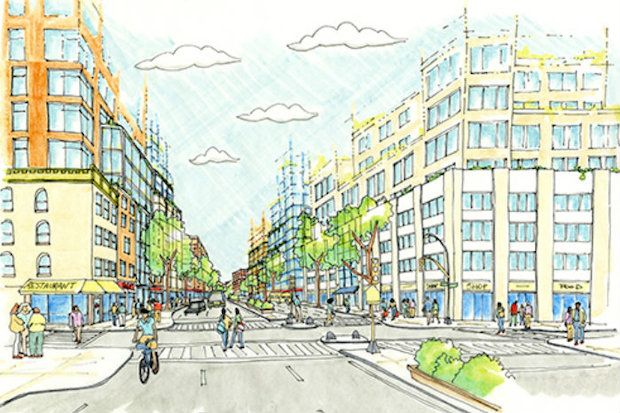
Housing Starts:Cushion Against Gentrification I BBPC Mulls Affordable Units I Long Lines for Lottery

Photo Credit: Department of City Planning of New York
- City Wants ‘Cushion Against Gentrification’ in East New York Rezoning City officials are planning a “cushion against gentrification” in East New York by reserving much of the area for up to 7,000 affordable housing units. Also a key component of the plan is to turn Atlantic Avenue, from Conduit to Jamaica Avenue, into a “vibrant” growth corridor with buildings up to 12 stories and shopping and services, officials told residents gathered in the Cypress Hills Community School on Saturday. A map of the proposed changes encompasses the northern area of East New York, from Pitkin Avenue to Fulton Street and a portion of Ocean Hill.
- Brooklyn Bridge Park Corp. Mulls Adding Affordable Units The Brooklyn Bridge Park Corporation is considering altering the official park plan to allow for the construction of affordable housing. The city-controlled entity noted the possible revision to the project in papers filed with the New York state Supreme Court last month. The idea of adding affordable units came in response to opponents alleging that Mayor Bill de Blasio’s affordable housing proposal violates the official plan, the Wall Street Journal reported. The plan for the 1.7-mile park includes five commercial sites. Four of the sites would have to include market-rate housing in the future. Pier 6, the fifth site, would contain below-market-rate housing.
- Long Lines and Low Odds for New York’s Subsidized Housing Lotteries Sitting in the back pew of a packed church in Fort Greene, Brooklyn, William Jamieson was hoping to learn some winning tips from a workshop on how to play New York City’s housing lotteries. The lotteries, which the city uses to distribute subsidized apartments in new buildings, can be hard to navigate, and Mr. Jamieson had applications pending for lotteries in two buildings. But surrounded by hundreds of other hopefuls at the church, he was not feeling particularly lucky. ‘I probably have a better chance playing the Lotto,’ said Mr. Jamieson, 46, a warehouse worker who rents a room in a six-bedroom house and was hunting for a studio or a one-bedroom. ‘There’s a lot of single people like me trying to apply.’
- Behind Booming East New York, Gentrification’s Last Frontier As both the De Blasio administration and those betting on real estate turn their sights to the neighborhoods beyond Bushwick, BedStuy, and Crown Heights, prices have already begun to rise in East New York. The neighborhood has been getting attention from the De Blasio administration, which has made it clear through a looming rezoning that the impoverished neighborhood is being seriously eyed as a location for the administration’s affordable housing initiative. The neighborhood has also attracted the attention of real estate speculators who are betting that the saturation of nearby neighborhoods like BedStuy, where median home prices have doubled since 2010, will course ‘the wave’ of gentrification to the impoverished neighborhood.
- Affordable-Housing Advocates Blast Tax Break for Developers A $1 billion-a-year property-tax break under investigation as part of the federal probe of Albany corruption is up for renewal later this year — and affordable-housing advocates are howling.
- Renewed Push for Unsafe-Buildings Bill Decried By REBNY Councilwoman Margaret Chin is renewing her push today for legislation that would allow the city to force landlords of unsafe buildings to set aside money for relocation expenses, something welcomed by tenant advocates but derided by the real estate lobby. The bill, in part, mirrors what the Department of Housing Preservation and Development can already do—that is, go after landlords to recover the cost of relocating tenants when a building is vacated due to hazardous living conditions.
- Rural America’s Housing Crisis Conversations about affordable housing are often dominated with the question of how to get lower-income residents in expensive cities—like New York, Los Angeles, or San Francisco (and their surrounding areas)—safe, affordable places to live. That makes sense: Often urban hubs are a good bet for jobs and economic vitality, but they’re also prohibitively expensive for many—creating well-known housing problems. But cities aren’t the only places that are lacking when it comes to adequate housing at affordable prices. In rural America, it’s both prices and the terrible condition of existing homes that are problematic.
- WNY Homeless Projects Get Almost $10 Million From HUD Nearly $10 million in federal grant money will be invested in programs to end homelessness in Erie and Niagara counties thanks to a coordinated effort by the Homeless Alliance of Western New York. The U.S. Department of Housing and Urban Development announced this week that 37 projects in Western New York will receive a total of $9.76 million toward housing and support services for the newly homeless, people in recovery and people coping with mental illness, among others, from the Continuum of Care program.
- More Than 1,500 People Sign Petitions to Save Harlem’s Community Gardens More than 1,500 people have signed a petitions asking Mayor Bill de Blasio to save several community gardens and a greenhouse, which provide fresh produce for the neighborhood, from being turned into affordable housing developments. The petitions to save the gardens comes a few weeks after the Department of Housing Preservation and Development published a list of city-owned sites that developers can apply to build on, including 15 community gardens.
- Dallas Case May Weaken Americans’ Ability to Fight Discrimination How the Supreme Court rules on a Dallas-based case that it’s now considering — Texas Department of Housing and Community Affairs v. the Inclusive Communities Project — will serve as a guidepost in how the U.S. will interpret civil rights-era legislation moving forward. The case challenges the interpretation of the Fair Housing Act as a tool meant to broadly protect those who are often targets of housing discrimination at a time when, as the New York Times points out in this op-ed, ‘persistent housing segregation remains a fact of life for many blacks.’


